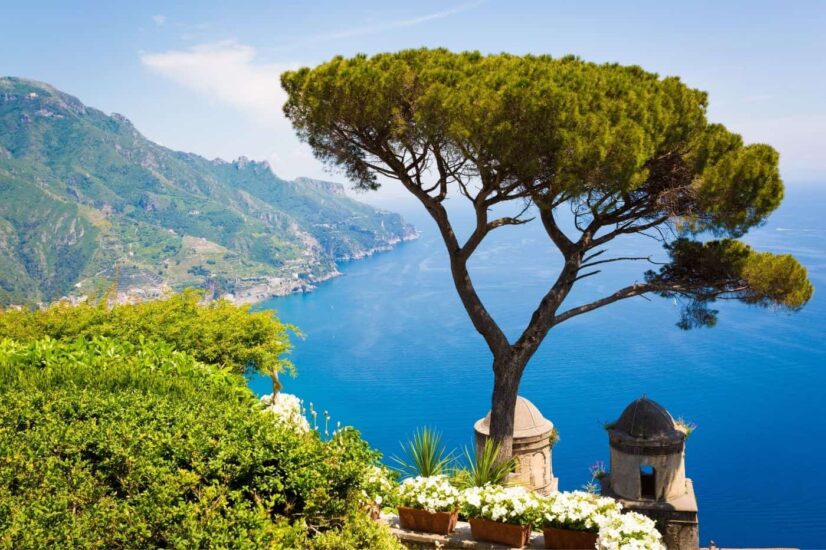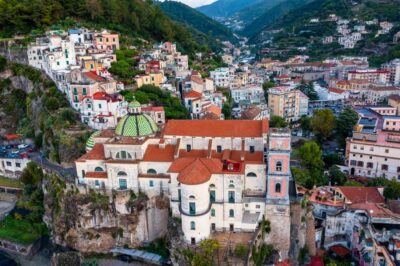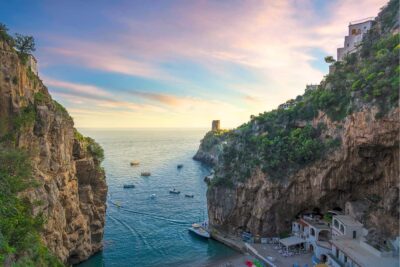Ravello, the ‘City of Music’. hosts every year the oldest Italian festival, second only to the ‘Maggio Musicale Fiorentino’, the ‘Ravello Festival’, dedicated to the world-famous monument of music history, Richard Wagner.
The structure is located at a place from which one can enjoy the panorama of the Amalfi Coast. The Auditorium Oscar Niemeyer is the flagship of contemporary architecture realised by what can be considered the Brazilian’s Picasso of concrete, Oscar Niemeyer, who put his heart and soul into this project.
Here are his words:
“…and I start to imagine, satisfied, this square built, worthy (perhaps) of the city of Ravello, one of the most beautiful in Italy…”.
Indice dei contenuti
History of the Oscar Niemeyer Auditorium

The small yet beautiful town of Ravello, city of music par excellence, wanted to find its proper redemption. This is why the ‘Ravello Project’ was born, which included the creation of a Foundation, the institution of a training school for musicians and the relaunch of the music festival.
The first contacts with the Brazilian architect were started by sociologist Domenico De Masi, who headed the project. Only in 2010, after years of legal wrangling, appeals and thousands of euro spent in vain, the majestic work was inaugurated, becoming a symbol of development and victory over the building speculation that has devoured kilometres of coastline.
The site on which the Oscar Niemeyer Auditorium stands was not chosen by chance, as the aim was to restore dignity to Ravello’s landscape, and it is also located near Villa Ruofolo, where open-air concerts are held.
Unfortunately Ravello’s uneven terrain was a challenge for the architect, who had to build a complex on a low budget while respecting the natural environment.
Oscar Niemeyer is not an unknown architect. In fact, he had already worked on the construction of Brasilia, the new capital of Brazil. On 11 June 2002, the ‘Ravello Foundation’ was established by Antonio Bassolino, President of the Campania Region, Secondo Amalfitano, Mayor of Ravello, Alfonso Andria, President of the Province of Salerno and Gabriello Mancini, President of the Monte dei Paschi di Siena Foundation.
The executive project for the Oscar Niemeyer Auditorium was realised by the Edil Atellana based in the Caserta area, on the basis of the final project complete with the improvements proposed during the tendering phase. One of the key aspects was the acoustics, which presented some issues.
The commissioning body solved them with an extraordinary collaboration between the design team and the other professionals who took part in the discussions. The team consisted of the head of architecture, the head of installations and the structural engineer who met weekly with the construction management, reported on the problems and came up with strategic solutions.
What the Ravello Auditorium looks like
The Oscar Niemeyer Auditorium is divided into three blocks: the first holds the auditorium, the second the car park, and the third is called the ‘support building’. In this last block there is a refreshment area, a large staircase system, the book shop and the box office.
Compared to the initial design, only changes were made to the furnishings in the bidding process by adapting the ancillary structures. Very interesting was the proposal for the car park with a structure that replaced the obsolete system of extrados beams with a more functional single-storey one. In the event of a fire, no pockets of smoke are created and this is essential to ensure safety in the case of large events.
The living part of the Oscar Niemeyer Auditorium was fitted with a custom-made acoustic system, with suitable furniture and cladding material. In addition, reflective panels made of slightly corrugated methacrylate material were arranged at the sides and at the stalls’ deck.
These panels are not fixed but are moved according to the orchestral configuration. Also in the final design, a glazing was provided to separate the stalls from the auditorium, to avoid heat loss and to comply with regulations, a 60 cm gap was left between the two panes of glass to allow air circulation.
The Oscar Niemeyer Auditorium has curving lines on the outside and bears the ‘signature’ of its designer. Only an attentive eye can discern similarities with a female figure lying on the side enjoying the view of Ravello.
Although Niemeyer accepted the commission, he never visited Ravello. It was his closest collaborators who carried out the inspections and took care of the commissioning of the Oscar Niemeyer Auditorium. Work began in October 2008 and was completed in January 2010. Doing a few calculations: 72 months to start the work, 40 months to finish it, and no less than 8 sentences to nullify the appeals of those who defined the work as “an eco-monster”.
The Oscar Niemeyer Auditorium, after the difficult path to the inauguration, risked being closed due to management disputes. The European Union intervened in the debate as it had allocated 5 million euro out of a total of 16 million for the start-up of cultural activities, but in the end only two concerts had taken place. Domenico De Masi himself denounced the state of abandonment of the structure, which was cracked and subject to infiltration.
Despite being a place of pilgrimage for architects, town planners and scholars who had come from all over the world to venerate the work of Niemeyer (who died in 2012 at the age of 105), the auditorium had become nothing more than an unauthorised car park for the town of Ravello.
Where the structure is located and how it is used today

The Auditorium Oscar Niemeyer is located in Via della Repubblica, 12. It is not far from Ravello’s historic centre and Piazza Vescovado, the main square overlooked by the Cathedral of San Pantaleone and the entrance gate to Villa Rufolo.
The Auditorium Oscar Niemeyer has a seating capacity of 400. Today, it is the ideal location for the Ravello Festival, a cultural and music festival that every summer offers high-level cultural events, dance and theatre performances, concerts, film screenings, meetings and conferences.
There are more than 300 executive project boards, and it is thanks to these meetings that it was possible to work in a relatively short time, if one does not consider the bureaucratic delays and clashes that remain in the national news.









